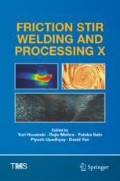Abstract
Dissimilar aluminum alloys 2024-T351 and 7075-T651 were friction stir welded utilizing a conventional tool and a bobbin-style tool. The welds produced with the conventional tool yielded higher mechanical properties than those produced with the bobbin tool, and fracture of all tensile specimens occurred on the 2024 side of the weld regardless of the tool or weld configuration. Temperature data and modeling demonstrated that the temperature distribution from either tool skews toward the advancing side. Ultimately, the mechanical properties and hardness profiles across the welds correlated with the temperature distribution and the associated precipitation behavior of the alloys. Optical microscopy revealed distinct layers of the alloys interwoven within the stir zone and identical grain sizes in both alloys. Grain boundary orientations from the stir zone followed the Mackenzie plot, suggesting complete recrystallization and a lack of texture within this zone.
Access this chapter
Tax calculation will be finalised at checkout
Purchases are for personal use only
References
Mahoney MW, Rhodes CG, Flintoff JG, Bingel WH, Spurling RA (1998) Properties of friction-stir-welded 7075 T651 aluminum. Metall Mater Trans A 29(7):1955–1964
Jones MJ, Heurtier P, Desrayaud C, Montheillet F, Allehaux D, Driver JH (2005) Correlation between microstructure and microhardness in a friction stir welded 2024 aluminium alloy. Scr Mater 52(8):693–697
Mishra RS, Ma ZY (2005) Friction stir welding and processing. Mater Sci Eng R Rep 50(1):1–78
da Silva AAM, Arruti E, Janeiro G, Aldanondo E, Alvarez P, Echeverria A (2011) Material flow and mechanical behaviour of dissimilar AA2024-T3 and AA7075-T6 aluminium alloys friction stir welds. Mater Des 32(4):2021–2027
Cavaliere P, Nobile R, Panella FW, Squillace A (2006) Mechanical and microstructural behaviour of 2024–7075 aluminium alloy sheets joined by friction stir welding. Int J Mach Tools Manuf 46(6):588–594
Khodir SA, Shibayanagi T (2008) Friction stir welding of dissimilar AA2024 and AA7075 aluminum alloys. Mater Sci Eng B 148(1):82–87
Mishra RS, Mahoney MW (2007) Friction stir welding and processing. ASM International, Materials Park, Ohio
Reza-E-Rabby M, Tang W, Reynolds AP (2015) Effect of tool pin features on process response variables during friction stir welding of dissimilar aluminum alloys. Sci Technol Weld Join 20(5):425–432
Koilraj M, Sundareswaran V, Vijayan S, Koteswara Rao SR (2012) Friction stir welding of dissimilar aluminum alloys AA2219 to AA5083—optimization of process parameters using Taguchi technique. Mater Des 42:1–7
Acknowledgements
Special thanks to Dr. Anthony Reynolds and Mr. Dan Wilhelm at the University of South Carolina for their expertise and facilities in the production of all welding configurations used in this study. Additionally, Dr. Mateusz Kopyściański and the Department of Metal Engineering and Industrial Computer Science at the AGH University of Science and Technology were very generous in their assistance and guidance during the examination phase of the study.
Author information
Authors and Affiliations
Corresponding author
Editor information
Editors and Affiliations
Rights and permissions
Copyright information
© 2019 The Minerals, Metals & Materials Society
About this paper
Cite this paper
Goetze, P., Kopyściański, M., Hamilton, C., Dymek, S. (2019). Comparison of Dissimilar Aluminum Alloys Joined by Friction Stir Welding with Conventional and Bobbin Tools. In: Hovanski, Y., Mishra, R., Sato, Y., Upadhyay, P., Yan, D. (eds) Friction Stir Welding and Processing X. The Minerals, Metals & Materials Series. Springer, Cham. https://doi.org/10.1007/978-3-030-05752-7_1
Download citation
DOI: https://doi.org/10.1007/978-3-030-05752-7_1
Published:
Publisher Name: Springer, Cham
Print ISBN: 978-3-030-05751-0
Online ISBN: 978-3-030-05752-7
eBook Packages: Chemistry and Materials ScienceChemistry and Material Science (R0)

